Collection Donation to the City of Zagreb: The Miroslav and Bela Krleža Memorial Space
Zagreb, Krležin Gvozd 23 (Google maps)
Information and notice on : 01/4834-922, 01/4851-361
CURRENTLY CLOSED FOR VISITORS.
Watch the video Memories of a genius
 The Home of Miroslav Krleža, who was without any doubt the most important Croatian writer of the 20th century, is the donation of Dr Krešimir Vranešić to the city of Zagreb. Dr Vranešić, the heir of Krleža, donated part of the Miroslav Krleža bequest, comprising antique furniture, paintings, sculptures, objects of the fine crafts, photographs, about 4,300 books, journals and offprints and the remaining inventory of the flat in which Miroslav and Bela Krleža had lived for almost thirty years. The giving and accepting of donations is an indicator of the cultural level and social awareness of a community, an indicator of care and responsibility to history and tradition.
The Home of Miroslav Krleža, who was without any doubt the most important Croatian writer of the 20th century, is the donation of Dr Krešimir Vranešić to the city of Zagreb. Dr Vranešić, the heir of Krleža, donated part of the Miroslav Krleža bequest, comprising antique furniture, paintings, sculptures, objects of the fine crafts, photographs, about 4,300 books, journals and offprints and the remaining inventory of the flat in which Miroslav and Bela Krleža had lived for almost thirty years. The giving and accepting of donations is an indicator of the cultural level and social awareness of a community, an indicator of care and responsibility to history and tradition.
To the question posed by Enes Čengić “What will happen to the flat after your death”
Krleža replied: "As far as this flat of mine is concerned, there are so many flats in history that went to rack and ruin and that were so much infinitely more important than my and Bela’s home. In our strange conditions, the maintenance of this dwelling means a big investment, and there will hardly be any factor capable of doing this financially in my case. But if anyone cares about preserving the memory of a poet and an actress who lived here for three decades, let them do it."
Thanks, though, to the donator of the inventory, Dr Vranešić, and the recipient of the donation and current owner of the flat, the city of Zagreb, the collection has been open to the public since December 19, 2001, the twentieth anniversary of the death of Krleža. As a result of a decision of the City Assembly, the memorial collection was confided to the care and management of Zagreb City Museum.
THE VILLA REIN
.jpg) The house at Gvozd 23 (formerly: Tuškanac 6A, Baroness Sofia Jelačić Put 1) was constructed on a commission from the banker Adolf Rein in 1928/9, according to drawings by the architect Rudolf Lubynski (1873-1935). The development of the plot and the buildings on it (a built garage, two gazebos, two pools) was completed in 1936 (A. Helfmann, contractor).
The house at Gvozd 23 (formerly: Tuškanac 6A, Baroness Sofia Jelačić Put 1) was constructed on a commission from the banker Adolf Rein in 1928/9, according to drawings by the architect Rudolf Lubynski (1873-1935). The development of the plot and the buildings on it (a built garage, two gazebos, two pools) was completed in 1936 (A. Helfmann, contractor).
The building has the form of an elongated cube, the mass of which is horizontally articulated by a strong cornice between basement and ground floor. The elevations are designed rather grandly with a motif of arches, repeated rhythmically along the lowest floor with a balcony and veranda on the southeast façade, and a loggia on the southwest. The floor plan is identical on the ground floor and on the first floor.
The garden is freely conceived, which corresponds aesthetically to the nearby woods. The plant species have been chosen so as to correspond to the particular location within the Tuškanac Woods. Alongside its southern edge, below the garage, leads a little path to the ground floor terrace, where there are two marble pedestals with sculptures of Pandora and Leda while a third sculpture, of Hebe, is in front of the entrance to the house, on top of the perimeter wall (Aristid Fontana, end of the 19th century).
This house is an excellent example of the residential villas of the wealthy classes of Zagreb between the wars.
MOVING IN
The part of Tuškanac that has since 1928 borne the name of the historical mountain Gvozd entered history thanks to a unique married couple, Bela and Miroslav Krleža, famous actress and great writer. In 1952 the couple moved from Kukovićeva ulica (today Hebrangova) 23 and went to Gvozd 23, the elite residential area of Zagreb. The flat at Kukovićeva had been large, but was located at a place where the heavy traffic and a number of noisy tradesmen disturbed the tenants’ peace and quiet. The couple were discontented, and had been wondering about finding some other solution. When Mrs Elizabeta Rein found out about this, she offered Bela the space on the first floor. At first Krleža himself was not very enthusiastic, but gave into Bela’s wish and thus the celebrated couple spent the last three decades of their lives here.
The house at Gvozd met all their expectations; the wonderful view of the Upper Town and of the tower of St Mark’s Church. Here they lived far from the bustle of the town, in Tuškanac park. Gvozd became a poetic house, a haven of the local setting, a museum of beauty, a meeting place for writers, politicians and artists.
THE MEMORIAL SPACE
Entrance porch The entrance lobby
.jpg)

In the entrance porch, at the bottom of the steps, with
a high plinth course of artificial stone (an imitation of
yellow marble), in a small semicircular arched niche,
is a bronze portrait of Miroslav Krleža, the work of the
sculptor Ivan Sabolić, of 1966. In this manner at the
spot where outside and inside join, the entrance into
the memorial is marked symbolically. Krleža is in
residence in Gvozd once again.
In the entrance lobby on the first floor we are greeted by
a bracket with a mirror, with metal appliqués, allegorical
figures and plant ornaments from the Empire (ca
1820/1830). On the mirror is a photograph of a smiling Krleža (photo by F. Vodopivac) with his hat raised, welcoming us in. Also here is a carved wooden chest
from Dalmatia (17th century) with stylised palmettos
and flowers, a nice specimen of the ethnic heritage.
Dining room
 From the hall, on the right, one enters into the one-time large “hall” clad with high oak panelling. With the added fireplace it creates the impression of a warm welcome, a friendly refuge, which was the idea of the architect, R. Lubynski. For the sake of practicality (closeness of the kitchen and the greatest distance from the study), Bela turned it into a dining room.
From the hall, on the right, one enters into the one-time large “hall” clad with high oak panelling. With the added fireplace it creates the impression of a warm welcome, a friendly refuge, which was the idea of the architect, R. Lubynski. For the sake of practicality (closeness of the kitchen and the greatest distance from the study), Bela turned it into a dining room.
It is dominated by a round Biedermeier veneered table on a baluster leg of 1840, alongside it a neo-Baroque easy chair of 1880, and a rocking chair, of more recent date, in which Krleža loved to sit.
Alongside the western and northern walls there is a two-door and a one-door Biedermeier china cabinet, with glazed doors, full of metal and porcelain tableware, an inheritance from Krleža’s Aunt Pepa. Between them is a neo-Baroque sofa, a three-seater (of about 1870).
Next to the door, the setting is completed with a Classicist occasional table with an inlaid top, on which there is a brass samovar, and an oil lamp, a set of shelves, meticulously made oriental miniature work (about 1860), with a collection of Chinese crockery and a table with a folding top, on which there is Bela’s collection of silver vessels from the second half of the 18th century.
On the walls, from left to right, oil paintings are dominant:
- the Fortress of Senj by A. Glavan, recalling Bela’s birthplace;
- Portrait of a Woman, the work of Petar Dobrović of 1914;
- Portrait of a Woman after Velasquez by Mersad Berber of 1975 (a gift from the artist to Bela);
- Village in the Snow, by Ivan Lacković Croata (tempera on glass);
- Hung Pheasant by V. Filakovac (attribution uncertain), and
- Portrait of Bela Krleža by Stojan Aralica (located next to the service entrance).
Today, the canvas Zeleni Kader [a First World War topic] by Krsto Hegedušić, known from the catalogue of the Zemlja art group, is missing (it once stood where the Dobrović painting hangs today).
 The copper and pewter vessels (cauldrons, teapots, cake tins, jugs, candles) were assembled by Bela in her passion for collecting. As she said once:
The copper and pewter vessels (cauldrons, teapots, cake tins, jugs, candles) were assembled by Bela in her passion for collecting. As she said once:
I did... I found that copper frying pan in an old
Zagreb cottage, and that flagon was brought by
a country woman in front of the theatre. I got
plenty of it from my Kangrgas and Vuksans.
There are some from Krleža’s aunt too, she
loved copper.
Over the fireplace, Krleža’s own touch, is a reproduction of the Renaissance portrait of the rich merchant Georg Gisz by Hans Holbein.
On the floor is a Turkmen carpet, covered in geometrical motifs in red, blue and black, while on the ceiling is a brass light fixture of the Hollander type, with five lamps, as if it were in some kind of tacit agreement with the Holbein painting.
On the chest of drawers, next to the door to Bela’s bedroom, is an old television with a modern museological intervention: on it Krleža’s travels, anniversaries and so on are screened.
The Loggia
From the dining room, through a large painted and glazed door, one moves out onto the loggia, an area designed for relaxation and reading.
It is graced with a table with a round veneered top, a braided edge, a wickerwork armchair and two small chairs (of oak and dark painted wood with a twined straw seat). It is dominated by a bust of a woman on a wooden pedestal, in folk costume, with arms crossed, carved out of white marble, a work by Vanja Radauš of 1952. Also here is Sculptor with Hammer and Chisel in Hands (leaning on an unfinished male torso), a bronze self-portrait by Radauš of 1953. Next to him is a the figure of a dark woman holding a vessel on her head with her raised arms; this is a piece of vernacular carving from a single piece of wood from Africa (present from some voyage?).

On the small table there is a round medal; on the obverse is a portrait of Krleža in a hat, and on the reverse the standing figure of Krleža. A double of it is today built into the façade of Krleža’s birth house at Radićeva ulica 7.
Bela’s small salon
Behind the double glazed door is Bela’s little salon (the yellow salon as it was also called).

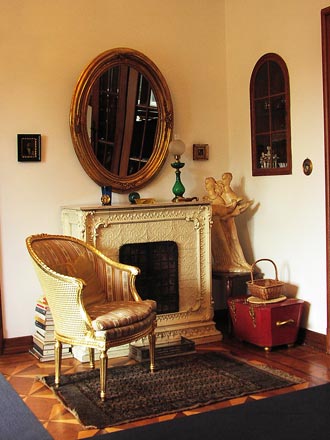 It would seem that it was originally the “heart of the five-roomed flat”, Bela’s great “theatre” – a stage with many revolutions, corners for varied moods, for everyone’s taste. We enter a space of mirrors and roses. The room was arranged with a lot of love, with memories, linking it with loved people. It served as a general meeting place and as such it had the function of being the mainstay of the house, and was complemented by the particular meeting place, Krleža’s study.
It would seem that it was originally the “heart of the five-roomed flat”, Bela’s great “theatre” – a stage with many revolutions, corners for varied moods, for everyone’s taste. We enter a space of mirrors and roses. The room was arranged with a lot of love, with memories, linking it with loved people. It served as a general meeting place and as such it had the function of being the mainstay of the house, and was complemented by the particular meeting place, Krleža’s study.
Towards the window there is an inlaid Classicist table (about 1800) with views of Venice and on the drawer and the side panels there are drawings of architecture (on the rectangular top there is almost always a large bunch of yellow roses). It is surrounded by two reproduction Classicist sofas with two high-backed armchairs (about 1930?) and a Biedermeier armchair with a new, striped, slipcover.
Further back, by the white fireplace, is another socialisation zone, with an armchair of gilded carved wood, a copy of Classicism with a slipcover of striped brocade. If necessary, if there were many guests, it would be joined by an identical armchair which is standing opposite it in front of a Biedermeier writing desk. On the floor, below both sets, are oriental carpets.
Above the fireplace is a large oval gilt mirror which has garlands done in relief along the axes. On the fireplace a bronze medal can be seen: Orpheus with Lyre, the work of the Parisian medal maker L. Coudray, of 1900, and next to the stone is Augustinčić’s Youth and Girl with Guitar, a plaster work of 1928.
Alongside the door, on the way to Krleža’s study are: a Biedermeier writing desk of walnut veneer, divided horizontally into three parts; at the bottom a double door; a central part with the writing top and a nest of drawers, flanked by black and white little columns (about 1830); above it is a pastel on card and blockboard, The Night Watch, an illustration to the Ballads of Petrica Kerempuh, the work of Z. Balabanić of 1970.
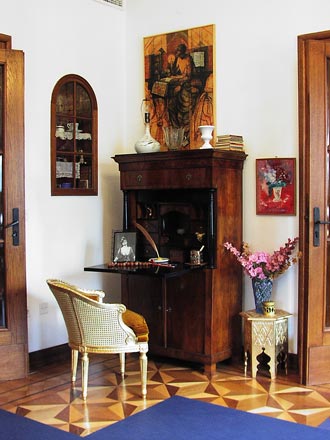 Next to the desk is a picture of a vase of flowers, tempera on paper, signed N. T., 1962. Next to the window is a very valuable Classicist writing cabinet on with three slightly convex, richly inlaid drawers with scenes from the hunt and rural architecture. Over the cabinet is an oil painting, Portrait of Bela Krleža, the work of the painter Jerolim Miše of 1931 (once in the dining room where Aralica’s portrait of Bela stands now; originally Dobrović’s portrait of the painter’s wife of 1926 stood here), and next to the window is a rectangular Venetian mirror in a gilt wooden frame (punched rocaille motif).
Next to the desk is a picture of a vase of flowers, tempera on paper, signed N. T., 1962. Next to the window is a very valuable Classicist writing cabinet on with three slightly convex, richly inlaid drawers with scenes from the hunt and rural architecture. Over the cabinet is an oil painting, Portrait of Bela Krleža, the work of the painter Jerolim Miše of 1931 (once in the dining room where Aralica’s portrait of Bela stands now; originally Dobrović’s portrait of the painter’s wife of 1926 stood here), and next to the window is a rectangular Venetian mirror in a gilt wooden frame (punched rocaille motif).
Next to the window, to the right, is a Biedermeier cabinet with three drawers, the two lower drawers being flanked with black painted columns; above it is a large oil “theatrical” Portrait of Bela Krleža as Baroness Castelli, a work by Nikola Reiser of 1951 done in an almost Impressionist manner (the painter’s personal gift to Bela). On the cabinet are blue Venetian glass and a photograph of Bela’s mother in a glazed blue frame, completely in harmony with the Reiser painting. The surrounding walls are decorated with several miniatures and a small oil painting of Mersad Berber – In Praise of Velasquez.
Bela’s little salon leaves the impression of being a place of ceremony that will relieve guests and visitors of their tensions. This sense of relaxation is aided by the gilt chandelier hanging from the ceiling, with its crystal glass decorations (24 lamps), which takes us off in our imaginations to the lagoons of Venice.
Bela’s bedroom
 Next to the small salon is Bela’s bedroom. Bela and Krleža slept in separate rooms, and each morning "she would play a new woman for him, this bathed, combed, perfumed woman would know how to wonder, to entertain, to advise, to fascinate with her directness and yet always to remain a little distant and unfathomable. Bela was a wife whom Krleža experienced in totality and who existed in this way."
Next to the small salon is Bela’s bedroom. Bela and Krleža slept in separate rooms, and each morning "she would play a new woman for him, this bathed, combed, perfumed woman would know how to wonder, to entertain, to advise, to fascinate with her directness and yet always to remain a little distant and unfathomable. Bela was a wife whom Krleža experienced in totality and who existed in this way."
These spaces are different from all the others in their harmonious intimacy and familiarity. The spouses had their oases of peace in them.
Bela’s room is dominated by the bed with an upholstered headboard (20th century piece) located next to the door to the dining room. Over it is the Portrait of a Woman by Mersad Berber with a dedication to Bela. Opposite the bed is a large two-door wardrobe with bevelled corners, richly inlaid with geometrical motifs in walnut veneer with the original metal locks, a magnificent piece of work (about 1750). Next to it, in front of the window, an inlaid writing cabinet (about 1850). On it is some chinoiserie: a night light with a metal stand, a brass figure of the seated Buddha and the goddess Guan Yin – the Buddhist saviour of mankind (three seated female figures with six hands on a lotus throne).
Left of the bed is a console Biedermeier dressing table (about 1830) – Bela’s second dressing space, and above it an oil-painting Portrait of Bela Krleža, a work by Cata Dujšin of 1950. Next to it, in the very corner, is a Biedermeier bedside table, in the form of a pillar, with a round plan, on a polygonal pedestal (about 1830). In front of the bed is a round occasional table with three-legged pedestal table (about 1850), and two armchairs with four turned legs, newly upholstered in velvet.
Left, next to the door of the small salon, is a Biedermeier commode, divided horizontally into four drawers (next to two of the drawers are black painted engaged columns). Above it is a rectangular mirror, with a gilt wooden frame (at the top of the rounded corners, a motif of rose garlands, at the bottom, in the same position, a motif of acanthus leaves). This was the constant site of Bela’s evening and morning toilette.

On the walls and on the cabinets is a sequence of framed photographs (mainly portraits of Bela as Baroness Castelli, and a group portrait with her mother and Krleža). Right, next to the door into the small salon, towards the corner stove, on the wall there are two small portraits of Bela: one by Mile Milunović of 1954, and the other one of Cata Dujšin. Next to that, Portrait of a Woman, by Nikola Reiser of 1950. On the stove is the celebrated photograph of Krleža (by F. Vodopivac) in a frame.
On the floor in front of the wardrobe and to the right of the bed are two oriental carpets, Turkmen work, with geometrical motifs, and on the ceiling a gilt wooden chandelier with six lamps.
Krleža’s study
Going back through Bela’s small salon, and behind the double glass door, one enters the old dining room. Krleža gave it a new use, turning it into his study.
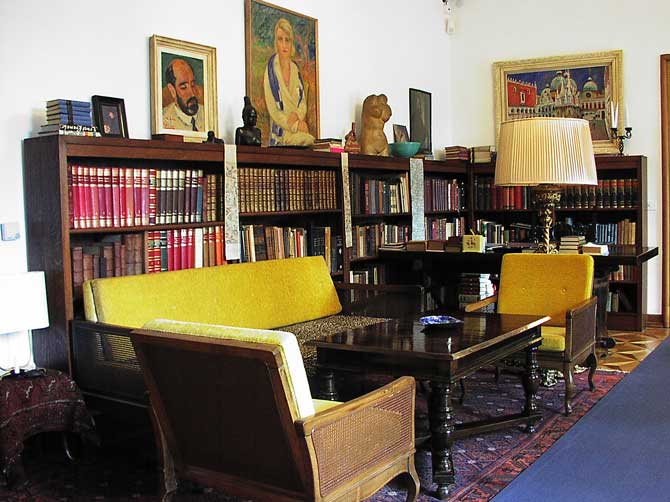
This is the biggest, best lighted and a relatively calm part of the flat, with a separate entrance and exit into the degagement (left) and a possible way out onto the balcony of the main elevation (to the right), a favourite place of the poet, from which he could see the tower of St Mark’s Church. Here is Krleža’s library, the mainstay of his life and work. Along all the walls are bookshelves and books, among them some unique works of great importance. The library numbers about 4,240 titles.
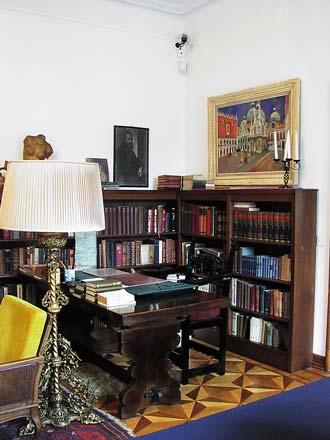 Krleža’s great desk of solid walnut, from 1930, with a neo-Renaissance chair is in the left corner, surrounded with dictionaries, grammars, encyclopaedias by old and new publishers from around the world. Once there was an old velvet-covered armchair in front of it, cardinal red, a place for Krleža’s occasional naps.
Krleža’s great desk of solid walnut, from 1930, with a neo-Renaissance chair is in the left corner, surrounded with dictionaries, grammars, encyclopaedias by old and new publishers from around the world. Once there was an old velvet-covered armchair in front of it, cardinal red, a place for Krleža’s occasional naps.
On the way to the exit into the hall is a suite for receiving guests – a sofa and two armchairs of solid wood and woven rush, and a table of solid walnut with baluster feet, work of the 20th century. In front of the bookshelf is a Biedermeier table of light walnut, with lyre-shaped legs and an inlaid strip on the top (about 1830).
On the other side is Bela’s piano with a 19th century Viennese mechanism (Rudolf Stelzhemner). On it is Bela’s portrait of 1925, a signed photograph framed in a silver frame, and two little sculptures: Marin Držić by A. Augustinčić, and Male Figure by A. Beslić.
Between the windows on the main façade is an inlaid tabernacle (the lower part has three drawers, the central part is a writing surface, and on top is a nest of drawers; on the central drawer are figures, fittings from the period of Louis XVI – the first half of the 18th century). Next to it is a copy of a Renaissance chair with a back.
Above the bookshelves, from left to right, there are a few pictures:
- a reproduction of the Holbein portrait of Erasmus (the original easel portrait of 1523 is in the Louvre);
- an oil painting Portrait of Miroslav Krleža, a gift from Petar Dobrović, 1930;
- a large oil painting Portrait of Dobrović’s Wife, created some time after 1930;
- reproductions of details of medieval frescoes from Sopoćani Monastery;
- a reproduction of the Portrait of Michelangelo (original portrait attributed to Jacopino del Conte from Casa Buonarotti in Florence); and
- a View of Venice (the Doge’s palace) by Petar Dobrović, 1938.

On the bookshelves are some smaller sculptures and pots: a bust of a black woman with her hair put up, of stained ebony, from Africa (Nigeria) – Tito’s gift to Bela; a zoomorphic funerary vessel, a monkey sitting and holding a vessel with a handle in the shape of a stirrup from South America (northern Andes) – the art of the Mochico Indians (between 200 BC to AD 700), the gift of the ambassador to Peru; and a torso of a female nude, a plaster cast by an unknown domestic author (once in Bela’s bedroom on the wardrobe).
The bookshelves are enhanced by two rather precious grey silk bands, on which, in differently coloured threads, landscape motifs have been embroidered with female figures in kimonos. In front of the sofa and the table is a Turkmen carpet with a red and dark blue knotting, and on the ceiling a gilt metal chandelier with 18 lamps.
Krleža’s bedroom
Through the door we go into Krleža’s bedroom, thus closing the circle that has led us from the “live theatre” towards solitariness, from public to private, from known to unknown, leaving the greatest mystery for the end. One enters a space of asceticism, of renunciation, the accumulation of carelessness.

Opposite the door, immediately in front of a bookshelf (dominated by Matoš, Gide and Baudelaire) is a modest bed with a slipcovered headboard. A little Philips radio is on the shelf; it was bought in Paris in 1952. To the left of the bed is a neo-Baroque table with a top with curved edges (about 1870) and to the right, in the corner, a large walnut, veneered and inlaid two-door wardrobe with bevelled corners, doors that are richly inlaid with plant ornaments.
Here, in front of the window, is a handy desk on four baluster legs, richly inlaid with plant ornaments (the year 1767 is inlaid into the top, and the Christ monogram IHS) and small table for the daily papers, from home and abroad. Most of the antique furniture in this room too is an inheritance from “Aunt Pepa” of 1922.
To the right, behind the door is a two-door wardrobe flanked with black pilasters of 1850, and on the left a little table with a board for writing on in bed and a metal stand (witness to Krleža’s sleepless nights). Alongside the stove, next to the bathroom door, is a Biedermeier cabinet of walnut of 1950, and over it is a reprint of a map of the voyages of Christopher Columbus of 1492, bought in Paris.
Over the bookcase, the dominant feature is a portrait of Krleža’s father, a charcoal work by Jerolim Miše of 1927; to the left is a political caricature by Daumier, of the philanthropist Robert Macaire, one of the original coloured lithographs from the album of the same name; to the right is a coloured reproduction of a detail from the scene of the Nativity (a woman pouring water from a jug) from the Sopoćani Monastery, 13th century, and next to the window is a reproduction of a detail of Michelangelo’s The Last Judgement from the Sistine Chapel (1534-1541).
On the way to the door of the bathroom, a framed collage of photographs hangs on the wall, showing important roles played by Bela (24 pictures), and next to the stove a portrait of Bela with a black lace fan in her hand, in the role of Baroness Castelli.
On the floor lies a Persian carpet (floral motifs on a brown ground), a gift from President Nasser when Krleža travelled to Egypt in 1962. From the ceiling hangs a gilt wooden chandelier with six lamps. All around, on the table and the wardrobe, on the floor behind the door, books, newspapers and magazines are scattered carelessly.
THE MUSEUM ADMINISTRATIVE AREA
 Coming out of the bathroom, we leave the Memoria behind and enter the new “museum administration” area, serving as “museum-memorial” and “museum-exhibition” space. On the floor of the bathroom there is a lino collage repeating the floor tile patterns and outlines of the sanitary equipment. At the moment we are showing here, through items found at Gvozd 23, Krleža’s life and work in four segments:
Coming out of the bathroom, we leave the Memoria behind and enter the new “museum administration” area, serving as “museum-memorial” and “museum-exhibition” space. On the floor of the bathroom there is a lino collage repeating the floor tile patterns and outlines of the sanitary equipment. At the moment we are showing here, through items found at Gvozd 23, Krleža’s life and work in four segments:
- right, behind the door of Krleža’s bedroom, a history of the Villa Rein;
- on the northern wall, on a map of the city of 1929, the addresses relating to Krleža’s life and education in Zagreb with photographs and short notes;
- on the western wall: a shallow display case with all the home and foreign editions of Krleža’s books (bottom left, old friend, books that Krleža would often re-read; bottom right, all the editions of the Ballads of Petrica Kerempuh – linked with a little room – the one-time toilet – where, through prints by eminent artists and a multimedia projection of the cartoon of Ballads of Petrica Kerempuh by Zlatko Bourek, who also painted the walls of the room, the impression of the ballads is heightened;
- all around on the walls, theatre posters of local and foreign performances with an emphasis on The Glembays series; posters for lectures by Krleža and the announcements of new magazines; a selection of photographs from foreign and local performances, and on two LCD screens, sequences from theatre performances and films.
In the corridor, the built-in wooden cupboards have been retained, but the wooden doors have been replaced with glass doors, and they have been thus turned into display cabinets. Here one can peek into the private and public lives of Miroslav and Bela Krleža: personal items, documents, decorations, letters, jewellery …
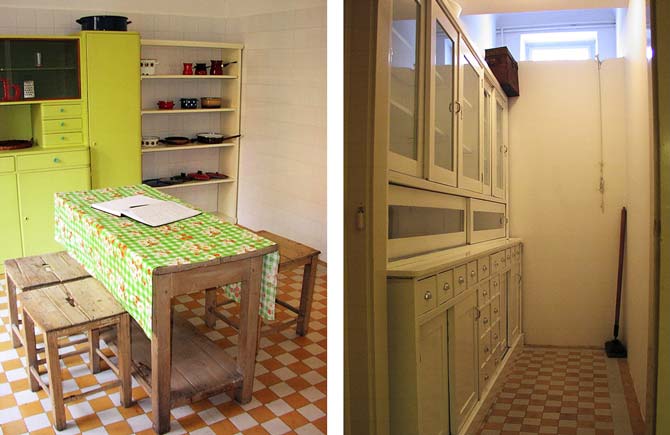
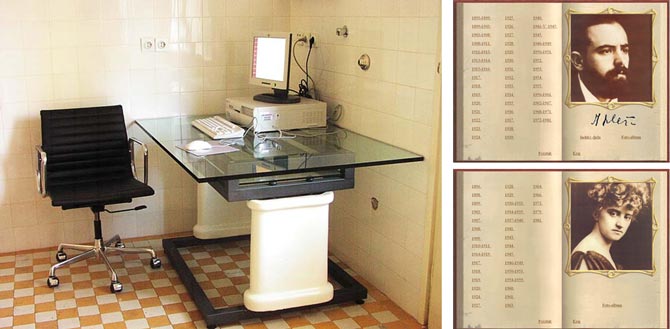
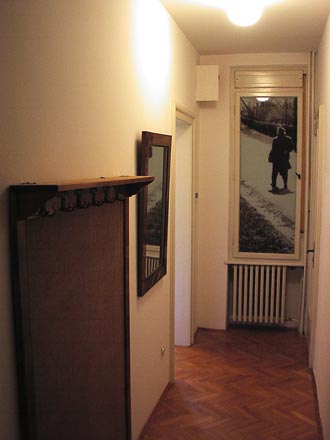 In the kitchen some parts of the furnishing have been kept (cabinets, shelves, table and chairs, crockery).On the top now is a computer, on which data about Miroslav and Bela Krleža can be searched for. The thick sheet of glass on the computer desk rests on the ceramic legs of the one-time sink.
In the kitchen some parts of the furnishing have been kept (cabinets, shelves, table and chairs, crockery).On the top now is a computer, on which data about Miroslav and Bela Krleža can be searched for. The thick sheet of glass on the computer desk rests on the ceramic legs of the one-time sink.
The maid’s room has become the room for the curator and a place for researchers; the archives are kept here, stored in two original cupboards.
In the larder the preserved cupboard is used for the storage of publications and other materials for sale and for the maintenance of the Memorial.
At the end of the exit hall (with an original coat rack), on the window pane, we can find an enlargement of the well-known photography of Krleža walking along Gvozd by Šime Radovčić, entitled Where is Krleža Going To? The visitors are leaving the Memorial, and Krleža is going with them.
BIOGRAPHIES
.jpg) MIROSLAV KRLEŽA was born on July 7, 1893 in Zagreb. He graduated from junior high school in Zagreb, and subsequently from the cadet school in Pécs, but he broke off his military studies in Pécs in 1913 and determined to be a writer; as early as 1914 he was writing and publishing in magazines and daily papers.
MIROSLAV KRLEŽA was born on July 7, 1893 in Zagreb. He graduated from junior high school in Zagreb, and subsequently from the cadet school in Pécs, but he broke off his military studies in Pécs in 1913 and determined to be a writer; as early as 1914 he was writing and publishing in magazines and daily papers.
After 1917 he published a number of books and founded four journals (Plamen, 1919; Književna republika, 1923-1927; Danas, 19343; Pečat, 1939-1950).
From 1950 on he was at the head of Lexicographic Institute, which today bears his name. He wrote many works for the theatre, including Galicia, on the repertoire of the Croatian National Theatre in Zagreb, which was banned one hour before the premiere on December 30, 1920.
The first drama performed was Golgotha, 1922, in the Croatian National Theatre in Zagreb; here other Krleža dramas had their first performance: In Agony, 1928; The Glembajs, 1939; and Leda, 1939, to mention only the best known. It was in Krleža’s dramas that his wife Bela (whom he married in 1919, spending 62 years with her) created her finest roles.
In the thirty years he lived at Gvozd Krleža wrote fewer works, devoted himself more to his job in the Lexicographic Institute, wrote articles and essays. However, during this time the drama Aretheus (1959) and the novel Banners (1962) were written, as well as the screenplay for the film The Way to Paradise (1970).
From mid-1977, Krleža never descended from Gvozd. He died on December 29, 1981.
.jpg) BELA KRLEŽA was born in Senj on October 26, 1896. She completed normal school in 1919 in Zagreb, and as teacher, worked in Donja Rijeka near Ludbreg, and from 1924 she worked in the University Library in Zagreb.
BELA KRLEŽA was born in Senj on October 26, 1896. She completed normal school in 1919 in Zagreb, and as teacher, worked in Donja Rijeka near Ludbreg, and from 1924 she worked in the University Library in Zagreb.
She learned acting privately from M. Mihičić and I. Badalić. She acted in the Croatian National Theatre from 1929 to her retirement in 1966. She had her biggest successes acting in the dramas of her husband. She appeared as Baroness Castelli in The Glembajs from the very first performance in 1929 to the last presentation in 1963; as Laura Lembah and Madlen Petrovna (In Agony), Melita and Klara (Leda) and Klara Anita in Aretheus.
Other leading roles she played are Nata in Nušić’s Mrs Minister, Belina in Molière’s Le Malade Imaginaire, Kitty Warren in G. B. Shaw’s Mrs Warren’s Profession, Mother in Tennessee Williams’ Glass Menagerie and Claire in Dürrenmat’s The Visit.
She died in Zagreb on April 23, 1981.
Slavko Šterk, Vesna Vrabec
Related publications
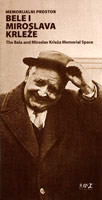 Šterk, Slavko; Vesna Vrabec. The Bela and Miroslav Krleža Memorial Space.
Šterk, Slavko; Vesna Vrabec. The Bela and Miroslav Krleža Memorial Space.
Zagreb : Zagreb City Museum, 2009

